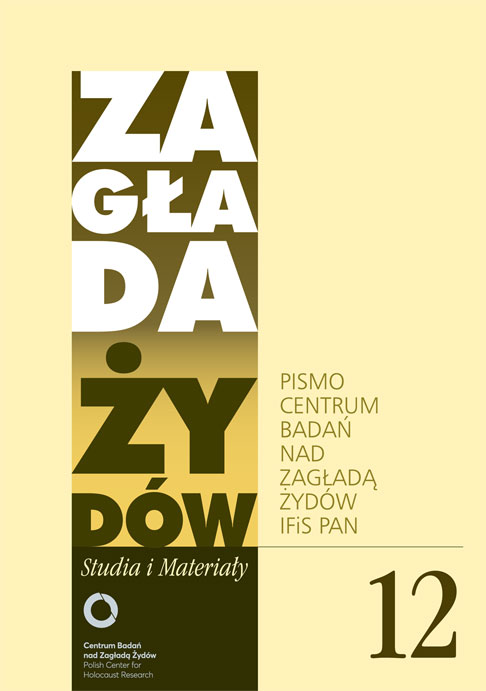Społeczeństwo holenderskie i los Żydów: skomplikowana historia
Zagłada Żydów. Studia i Materiały, Nr 12 (2016), Strony: 425-434
Data zgłoszenia: 2020-10-20Data publikacji: 2016-11-30
 https://doi.org/10.32927/ZZSiM.426
https://doi.org/10.32927/ZZSiM.426
Abstrakt
The percentage of victimization of Dutch Jewry during the Shoah is the highest of Western, Central and Southern Europe (except, perhaps of Greece), and close to the Polish one: 75%, more than 104.000 souls. The question of disproportion between the apparent favorable status of the Jews in society – they had acquired emancipation in 1796 - and the disastrous outcome of the Nazi occupation as compared to other countries in general and Western European in particular has haunted Dutch historiography of the Shoah. Who should be blamed for that outcome: the perpetrators, i.e. the Germans, the bystanders, i.e. the Dutch or the victims, i.e. the Dutch Jews? The article first surveys the answers given to this question since the beginnings of Dutch Holocaust historiography in the immediate post-war period until the debates of today and the factors that influenced the shaping of some basic perceptions on “Dutch society and the Jews”. It then proceeds to detailing several facts from the Holocaust period that are essential for an evaluation of gentile attitudes. The article concludes with the observation that – in spite of ongoing debates – the overall picture which has accumulated after decades of research will not essentially being altered. Although the Holocaust was initiated, planned and carried out from Berlin, and although a considerable number of Dutchmen helped and hid Jews and the majority definitely despised the Germans, considerable parts of Dutch society contributed to the disastrous outcome of the Jewish lot in the Netherlands – through a high amount of servility towards the German authorities, through indifference when Jewish fellow-citizens were persecuted, through economically benefiting from the persecution and from the disappearance of Jewish neighbors, and through actual collaboration (stemming from a variety of reasons). Consequently, the picture of the Holocaust in the Netherlands is multi-dimensional, but altogether puzzling and not favorable.
Słowa kluczowe
społeczeństwo holenderskie wobec Żydów , literatura o Zagładzie w Holandii
Licencja
Prawa autorskie (c) 2016 Autor&"Zagłada Żydów. Studia i Materiały"

Utwór dostępny jest na licencji Creative Commons Uznanie autorstwa 4.0 Międzynarodowe.
https://creativecommons.org/licenses/by/4.0
Czasopismo publikowane jest w standardzie Diamond Open Access na licencji CC-BY-4.0 Deed - Uznanie autorstwa 4.0 Międzynarodowa - Creative Commons
Inne teksty tego samego autora
- Avner Shalev, Dan Michman, David Silberklang, Ścisła pamięć o Zagładzie w Muzeum Historii Holokaustu w Yad Vashem. Odpowiedź na artykuł Amosa Goldberga , Zagłada Żydów. Studia i Materiały: Nr 7 (2011)
Podobne artykuły
- Adam Kopciowski, Dariusz Libionka, Relacja działaczki Poalej Syjon-Lewicy Poli Elster o sytuacji na Umschlagplatzu i w transporcie do Poniatowej w kwietniu 1943 r , Zagłada Żydów. Studia i Materiały: Nr 19 (2023)
- Andrzej Żbikowski, Lidia Zessin-Jurek, Katharina Friedla (red.), Syberiada Żydów polskich. Losy uchodźców z Zagłady [Andrzej Żbikowski] , Zagłada Żydów. Studia i Materiały: Nr 17 (2021)
- Basia Temkin-Bermanowa, Barbara Engelking, „Z dziejów archiwum Żydowskiego Ruchu Podziemnego” Basi Temkin-Bermanowej , Zagłada Żydów. Studia i Materiały: Nr 19 (2023)
- Barbara Engelking, Paweł Śpiewak , Zagłada Żydów. Studia i Materiały: Nr 19 (2023)
- Dariusz Libionka, Anna Bikont, Sendlerowa. W ukryciu , Zagłada Żydów. Studia i Materiały: Nr 13 (2017)
- Dariusz Libionka, Odpowiedź na list Joshui Zimmermana , Zagłada Żydów. Studia i Materiały: Nr 13 (2017)
- Marta Tomczok, Kinga Piotrowiak-Junkiert, Świadomość zwrócona przeciwko sobie samej. Imre Kertész wobec Zagłady , Zagłada Żydów. Studia i Materiały: Nr 12 (2016)
- Marta Tomczok, Literatura polska wobec Zagłady 2000 – 2024. Bilans subiektywny , Zagłada Żydów. Studia i Materiały: Nr 20 (2024)
- John Pawlikowski OSM, Kościół katolicki a zagłada Żydów: Perspektywy instytucjonalne , Zagłada Żydów. Studia i Materiały: Nr 5 (2009)
- Monika Stolarczyk-Bilardie, „Skoro Stolica Apostolska w 1942 wiedziała o tych wszystkich rzeczach, to dlaczego nie wykrzyczała [tego] światu?” Watykan wobec Zagłady: informacje z okupowanej Polski i ich odbiór za Spiżową Bramą, 1941–1943 , Zagłada Żydów. Studia i Materiały: Nr 20 (2024)
<< < 1 2 3 4 5 6 7 8 9 10 11 12 13 14 15 16 17 18 19 20 21 22 23 24 25 26 27 28 29 30 31 32 33 34 35 36 37 38 39 40 41 42 43 44 45 46 47 48 49 50 > >>
Możesz również Rozpocznij zaawansowane wyszukiwanie podobieństw dla tego artykułu.
 English
English
 Język Polski
Język Polski



 https://orcid.org/0000-0001-7496-496X
https://orcid.org/0000-0001-7496-496X

